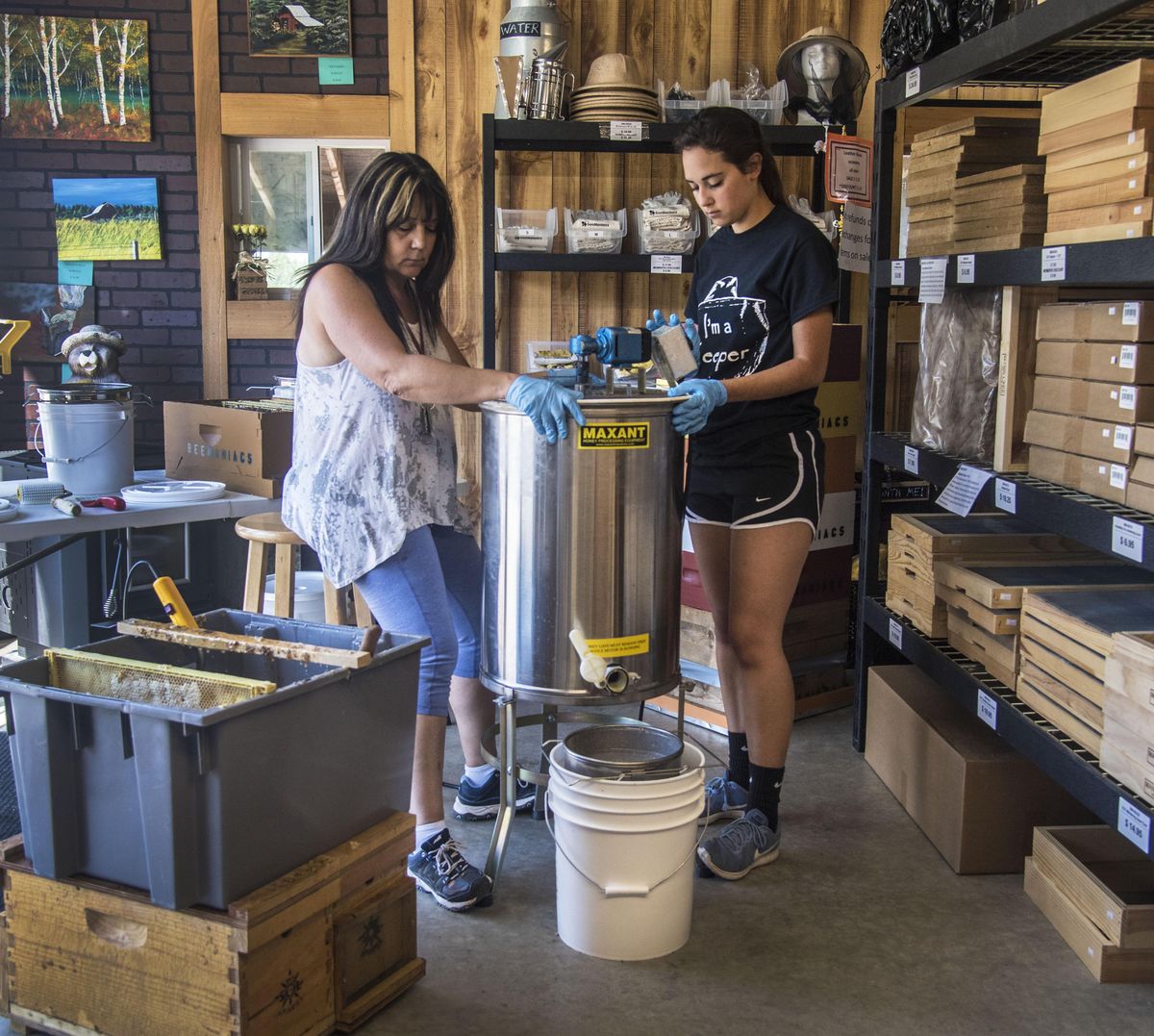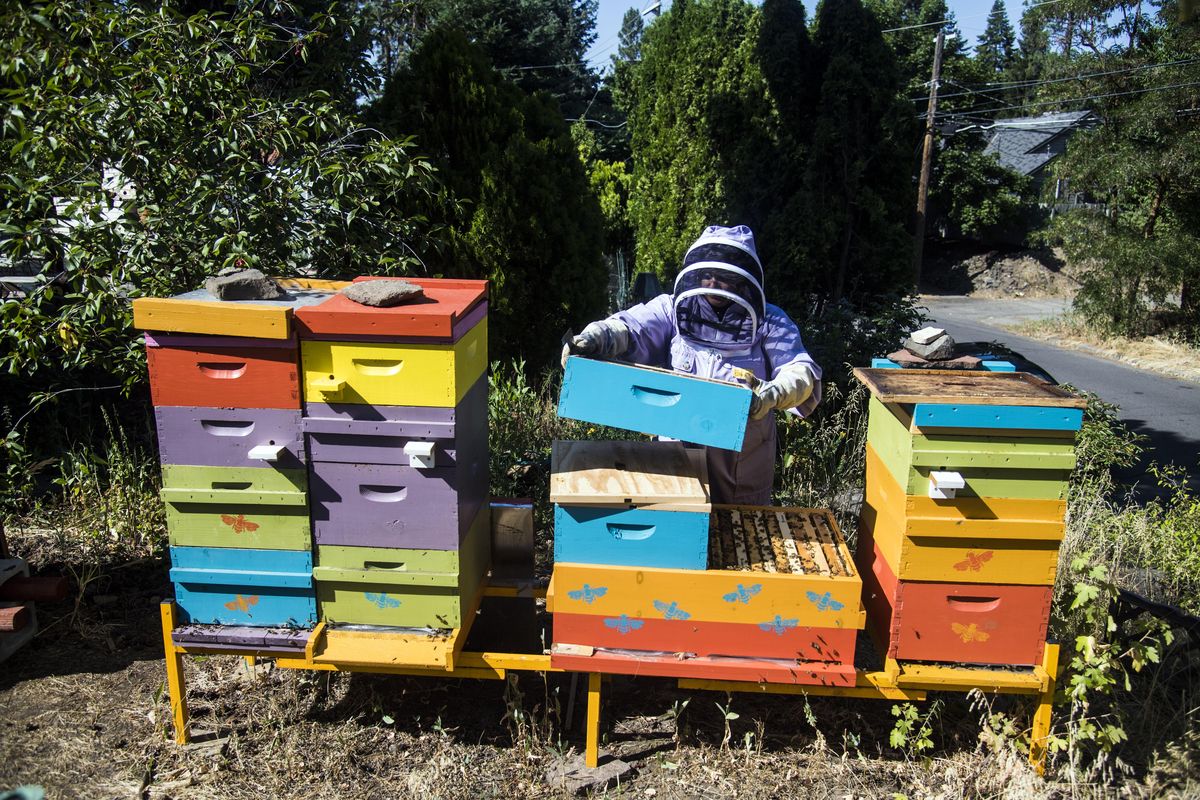Hundreds of new beekeepers help Spokane honeybees rebound
Kimberlee Kealiher lives on the South Hill and runs a hobby bee operation in her yard, July 18, 2017, in Spokane. Her bee hives are colorful and the location is unique being located on a tiny hill that overlooks 29th Avenue. (Dan Pelle / The Spokesman-Review)Buy a print of this photo
It’s been just over a decade since the 2006 colony collapse that devastated U.S. bee populations, wiping out billions of the nation’s pollinators. The “great collapse,” as it has become known, was a milestone in society’s acknowledgment of the vital role bees play in guaranteeing the world’s produce supply.
In Spokane, the number of concerned locals has been steadily increasing in recent years. To accommodate the growing interest, a group of small-scale keepers started the Backyard Beekeeper’s Association as an educational outlet for those looking to pursue hobby keeping – otherwise known as backyard beekeeping.
The association was created on the notion that if you have the right tools, a backyard and – most importantly – the right education, you can make a significant difference in restoring local bee populations.
“Year after year we see more people interested in keeping bees,” said Ari Alvarez, one of the founders of BYAB and owner of Bee Maniacs in Deer Park. “The people’s interest actually skyrocketed.”
BYBA was founded in 2015, and in just two years, more than 300 eager members have joined.
The rapid and, according to Alvarez, somewhat unexpected response from locals prompted the creation of online courses as well. The series of online beginner classes began earlier this year and has already filled up for the season.
But beekeeping is no easy task, apiarists say. Without proper education, research and mentoring, even the most enthusiastic beginning keepers can struggle to properly maintain their hives.
“Even though the hobby or backyard keeper may be concerned about the bees, it is not uncommon for us to see beginners kill their packages in record time,” Alvarez said. “This is largely due to lack of education.”
According to Alvarez, uneducated keepers are one of the largest killers of local bee populations.
“There is nothing worse than handing off a package of live animals to someone and they come back a day later saying, ‘Now what do I do with them?’ ” said Kimberlee Kealiher, the vice president and education coordinator for BYAB and owner of Saint Abi’s Bees on the South Hill. “You wouldn’t give a puppy away to someone you knew couldn’t take care of them. It’s the same with bees.”
Backyard beekeepers have only a handful of hives on their property. Each hive can hold up to 60,000 honey bees.
Aside from hobbyists, there are sideliner keepers, who manage 500 hives or less, and commercial keepers, who can manage thousands. Hobbyist, sideliner and commercial keepers differ vastly from one another both in size, business approach and colony maintenance methods.
Although commercialists and sideliners seem unrivaled by the hobbyists, there are hundreds of backyard keepers for every single large-scale operator. However, it only takes one disease-ridden bee colony in Spokane to potentially contaminate hives down the coast of California and beyond, should that disease go unnoticed by the keeper, apiarists say.
This is due to a bee’s ability to travel up to 3 miles from its hive in search of food. During their journey, the bees may come across neighboring hives that are contaminated, picking up the disease and bringing it back to their home hive.
“You need to be testing, you need to be looking, you need to be checking your bees often,” Alvarez said.
Occasionally, neighboring hives may include a large plot of commercial hives.
Commercial keepers usually start their season in California, where bees from all over the U.S. are moved to pollinate almond trees. From there, colonies are transported according to bloom routes. Keepers will move hundreds of hives up through Oregon and then over to areas such as Washington and Montana, where farmers need the pollination.
Commercial keepers normally move millions of bees at a time. This increases the likelihood of cross-contamination to or from other keeper’s bees all over the nation, carrying the infected hives from one location to the next.
This interdependence of bees and keepers is often underestimated by new hobbyists.
“In the beginning, it didn’t really occur to me that what I do will contribute to the greater good or the greater loss of bees,” said Faith Carr, a beginning keeper with BYAB. “It made me feel responsible and made me realize that if I’m going to get into this, I need to get it right.”
In addition to the new online courses, BYAB holds monthly hands-on workshops and meetings, addressing issues that are common amongst beginner keepers. These include managing swarms, honey extraction, seasonal keeping and, most importantly, hive health inspections.
One of the biggest threats to hives are varroa mites. The mites attach themselves most often to drones, or male bees, which then bring them back to the hive cells where they can multiply four times faster than the bees themselves.
A single mite could cost a keeper an entire colony. When the mite is picked up from a single hive and brought into others, it is referred to as a mite bomb.
As with humans, viruses specific to bees are constantly evolving. Alvarez stresses that new research is constantly being released from universities and other facilities and it is a keeper’s job to continually educate themselves on developing diseases.
“Even some of the best beekeepers lose their hives, there are just some things you can’t plan for,” Kealiher said. “But your best bet is to get out and get educated and fully understand the task that you are taking on.”




